* Acting presidents are not counted in total
Massachusetts Agricultural College
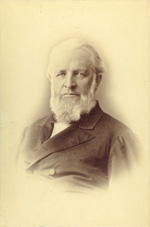 Henry Flagg French became the first president of the Massachusetts Agricultural College in 1864. A native of New Hampshire and graduate of Dartmouth College and Harvard Law School, French enjoyed agriculture. He operated a farm and conducted soil improvement experiments. He was considered a leader in the emerging application of science to agriculture.
Henry Flagg French became the first president of the Massachusetts Agricultural College in 1864. A native of New Hampshire and graduate of Dartmouth College and Harvard Law School, French enjoyed agriculture. He operated a farm and conducted soil improvement experiments. He was considered a leader in the emerging application of science to agriculture.
French held the post of president for two years, resigning in 1864 over a controversy regarding the location and nature of the first campus buildings.
After leaving Amherst, French was admitted to practice before the U.S. Supreme Court. While in Washington D.C. in the 1870s, he was assistant secretary of the treasury, and occasionally sat as a member of the President's Cabinet.
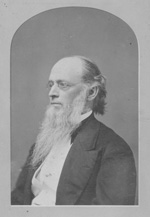 Paul Ansel Chadbourne served as the second president of the Massachusetts Agricultural College. With Levi Stockbridge and Henry Goodell, he has the distinction of having been named president twice.
Paul Ansel Chadbourne served as the second president of the Massachusetts Agricultural College. With Levi Stockbridge and Henry Goodell, he has the distinction of having been named president twice.
Chadbourne was born in North Berwick, Maine. After graduating from Williams College and teaching for several years, he joined the faculty of Williams College as professor of chemistry, botany, and natural history in 1883. Interested in politics, Chadbourne served in the Massachusetts Senate in 1865 as a member of the new Republican Party. He was appointed to the state Board of Agriculture, where he met several of the founders of the college.
His first term began in 1866, with a vigorous push for the construction of buildings for the campus, including South College and College Hall. Chadbourne's term also saw the development of the college's first curriculum. But he resigned due to ill health before the college opened to admit its first class of students.
He later accepted the position of President and Professor of Metaphysics at the University of Wisconsin at Madison from 1867 to 1870. Two years later he returned to Williams College to assume the duties of president there until 1881.
Chadbourne returned to the Massachusetts Agricultural College in 1882, 15 years after the conclusion of his first term. In his second term, he advocated for financial support for poor students and additional funding for expansion of the campus and the faculty. He also reformed the curriculum, offering two broad courses of study, one "agricultural and scientific" and the other "scientific and literary." Chadbourne intended to close the gap between the agricultural college and the more established liberal arts colleges. The new curriculum he planned had not yet come into effect by the time of his death in 1883.
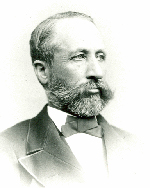 William Smith Clark was one of the most colorful figures in the history of the Massachusetts Agricultural College.
William Smith Clark was one of the most colorful figures in the history of the Massachusetts Agricultural College.
Clark was born in 1826 in Ashfield, Massachusetts. He graduated from Amherst College in 1848, and went on to teach the natural sciences at Williston Seminary until 1850. Clark then went abroad to Germany for two years to study chemistry and botany at Goettingen, earning his Ph.D in 1852. From 1852 to 1867 he was a member of Amherst College's faculty as a professor of chemistry, botany, and zoology.
As a leading citizen of Amherst, Clark was a strong advocate for the establishment of the new college there. He was appointed to serve as one of the founding members of the college's faculty and, following the resignation of Paul Chadbourne, Clark was named President in 1867, the year the college welcomed its first class of 56 students.
During his presidency, Clark pressured the state government to increase funding for the new college and provide scholarships to enable poor students, including women, to attend. The college faced economic hardship early in its existence: enrollment dropped in the 1870s, and the college fell into debt.
In 1876, Clark traveled to Japan at the request of the Japanese to establish an agricultural college at Sapporo. He is still remembered in Japan for his famous parting words: "Boys, be ambitious!" In Amherst, Clark strongly supported agricultural experimentation, conducting research himself on the circulation of sap in the sugar maple.
In 1879, Clark requested another leave of absence to establish a "floating college," a ship which would carry students and faculty around the world. His request was denied, and he resigned.
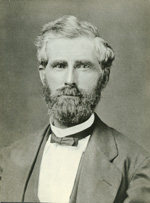 When the Massachusetts Agricultural College was being developed in 1867, Levi Stockbridge became the farm superintendent and an instructor in agriculture. As professor of agriculture from 1869 to 1880, he had a hand in the development of the Experiment Station. He was well known for his work on improving crop production and for developing formulas for mixing fertilizers.
When the Massachusetts Agricultural College was being developed in 1867, Levi Stockbridge became the farm superintendent and an instructor in agriculture. As professor of agriculture from 1869 to 1880, he had a hand in the development of the Experiment Station. He was well known for his work on improving crop production and for developing formulas for mixing fertilizers.
Stockbridge was appointed acting President of the College in 1876 and President of the College in 1880, serving until 1882. The college survived through great financial stress during his tenure. Amid the budget difficulties, Stockbridge advocated for more scholarships for students and greater investment in the college's physical plant. In 1882, he retired from the College, and was named an honorary professor of agriculture.
Stockbridge was born in Hadley, Massachusetts, in 1820. He was active in local politics, winning a seat in the Massachusetts House of Representatives in 1855, 1870, and 1883, and in the State Senate for 1865-66. In 1880 he ran for a seat in the U.S. Congress on the Greenback ticket. He was also a town selectman, town assessor, and town meeting moderator in Amherst.
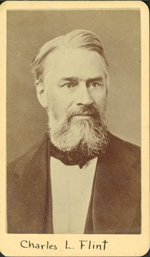 Selected during a budgetary crisis, Charles L. Flint agreed to serve as president of the Massachusetts Agricultural College without a salary.
Selected during a budgetary crisis, Charles L. Flint agreed to serve as president of the Massachusetts Agricultural College without a salary.
Flint was one of the founders of the Massachusetts Agricultural College and was elected secretary of the Board of Trustees, a position he held for 22 years. For four years he gave lectures at the college on dairy farming. On the resignation of President Clark in 1879, Flint was elected president. He resigned in the spring of 1880.
Flint was born in Middleton, Massachusetts, in 1824. He worked his way through Harvard, graduating in 1849, taught for a short time, then returned to Harvard in 1850 to enter the Law School. In 1853 Flint left his law practice to become secretary of the newly formed Massachusetts Board of Agriculture, remaining in that position for 27 years. He had a part in the founding of the Massachusetts Institute of Technology, and was a member of the Boston School Committee.
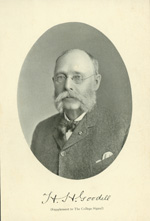 Henry H. Goodell was born in Constantinople on May 20, 1839. He was sent to the United States at the age of 17 and graduated from Amherst College in 1862. Upon graduation, Goodell joined the 25th Connecticut Volunteers for one year.
Henry H. Goodell was born in Constantinople on May 20, 1839. He was sent to the United States at the age of 17 and graduated from Amherst College in 1862. Upon graduation, Goodell joined the 25th Connecticut Volunteers for one year.
When the Massachusetts Agricultural College opened in 1867, Goodell was appointed professor of modern languages and English literature. During the next twenty years he taught many other subjects as well, such as military tactics, the natural sciences, rhetoric, elocution, and history. He also was the first college librarian, advocating for expansion of its collection. In 1886 Goodell was chosen president of the college, serving until 1905.
Under Goodell, many changes occurred at the college. The first women were admitted in 1892. The faculty of the college was strengthened with the addition of assistant professors. New courses were added to the curriculum, and a regular program of graduate-level instruction began. Seniors were offered elective courses for the first time. The first doctoral degree was granted in entomology in 1902. The Experiment Station began operations in this period, and Goodell served as its director for several years. Goodell also ended the practice of compulsory student labor on the college farm. In 1905, at the end of his term, the college had an undergraduate enrollment of 218 and its largest entering class of freshmen.
Active in town affairs, Goodell served in the Massachusetts House of Representatives in 1885 and 1886 and was involved in the Amherst town library.
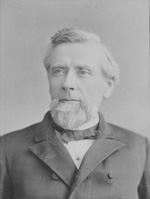 James C. Greenough was born in 1829, near the Amherst campus in Wendell, Massachusetts. He worked as a schoolteacher in Heath, Massachusetts, from 1854 until returning to the State Normal School at Westfield in 1856 to become assistant principal.
James C. Greenough was born in 1829, near the Amherst campus in Wendell, Massachusetts. He worked as a schoolteacher in Heath, Massachusetts, from 1854 until returning to the State Normal School at Westfield in 1856 to become assistant principal.
He left Westfield in 1871 to become principal of the Rhode Island Normal School, remaining at that post for 12 years.
In 1883, Greenough came to the Massachusetts Agricultural College to become president, serving for three years. During his tenure, he was noted for raising academic standards, extending the course of study, and guiding a transition from a small vocational college to a more comprehensive institution supporting agriculture and extension services. Greenough saw the construction of the college chapel and the establishment of the Experiment Station before finishing his term in 1886.
William Penn Brooks was born in South Scituate, Massachusetts in November of 1851. He entered the Massachusetts Agricultural College in 1871 and graduated with high honors in 1875. During his undergraduate years he participated in Dr. William Smith Clark's famous experiments on plant physiology. Brooks remained at the Massachusetts Agricultural College as a graduate student in chemistry and botany. During this time, Brooks accepted an invitation from the Japanese government to go to Sapporo to teach. Brooks arrived in Japan in January, 1877 to continue the work begun by Clark to establish the Sapporo Agricultural School. Immediately after his arrival, he began to deliver lectures on agricultural science and took charge of the directorship of the experimental fields. Brooks worked at the Sapporo Agricultural School for twelve years, four of which he served as the college president. Along with his teaching, Brooks made a great number of contributions as an agricultural advisor for the Sapporo provincial government. He introduced onions, corn, beans, forage and other plants to Japan.
In 1882, Brooks returned to America and married Miss Eva Bancroft Hall. They lived in Sapporo for seven years during which time they had two children. Their daughter, Rachel Bancroft Brooks, married Mr. George Drew in 1907. Their son, Sumner Cushing Brooks, married Matilda Moldenhauer while they were both students at Harvard.
Brooks returned to America with his family in October 1888. On leaving Japan, the government bestowed on him the Fourth Order of Merit and the Cordon of the Rising Sun. In 1920, the Minister of Education in Japan conferred on him the degree of Doctor of Agriculture.
In 1889, Brooks was appointed professor of agriculture at the Massachusetts Agricultural College, and at the same time he began to serve as an engineer at the Massachusetts Agricultural Experiment Station. During this time he introduced soybeans to the United States. In August 1896, Brooks went to Germany with his family and studied at Halle for one year where he received his doctorate. After his return from Germany, Brooks became interested mainly in experimental enterprises. He served as President of the Massachusetts Agricultural College from 1905 until 1906. In 1906, he became director of the Station and he remained connected with the college solely as a lecturer. Brooks was an advisor to the Station until 1921. His contributions to agriculture have been mainly published as reports of the schools, the Experiment Station, the state agricultural department, and the societies to which he was connected. Brooks also authored a textbook in three volumes entitled Agriculture and a collection of his lectures were published under the title Science as Applied to Agriculture. In 1932, the Massachusetts Agricultural College granted Brooks an honorary degree of Doctor of Agriculture.
In 1924 Brooks's wife died; three years later he married Ms. Grace Holden. Brooks cultivated his own garden in Amherst where he lived until his death on March 8, 1938 at the age of 87. In a letter written to one of his students Kingo Miyabe he wrote: "I was born in November, 1851, and to my pleasure I am still living in good health. I can still drive the automobile myself and do all the work in my garden. Nothing gives me more pleasure than cultivating vegetables, fruit-trees, and flowering plants and it is this work that is keeping me in such sound health. Now I have twenty odd kinds of hybrid tea roses and they have been in blossom since the middle of June."
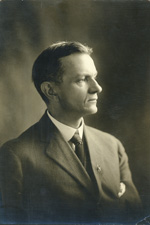 Kenyon L. Butterfield served as president of the college during an important growth period in the early part of the 20th century. Butterfield came to Massachusetts from the Rhode Island School of Agriculture where he had served as president. He started his career in Michigan, where he had edited the Michigan Grange Visitor, worked as superintendent of the Michigan Farmers' Institute, and taught rural sociology at Michigan Agricultural College.
Kenyon L. Butterfield served as president of the college during an important growth period in the early part of the 20th century. Butterfield came to Massachusetts from the Rhode Island School of Agriculture where he had served as president. He started his career in Michigan, where he had edited the Michigan Grange Visitor, worked as superintendent of the Michigan Farmers' Institute, and taught rural sociology at Michigan Agricultural College.
Butterfield became president of the Massachusetts Agricultural College in 1906, remaining until 1924. He made major changes on the campus, doubling the size of the staff and recruiting faculty from across the country to offer more specialized instruction. He organized the academic departments into five divisions, himself heading the division of rural social science. From 1906 to 1916, the institution's budget expanded from $150,000 to $700,000 by attracting research funding. Passionate about education's potential to benefit farming communities, Butterfield instituted a host of outreach programs, including summer schools for farmers, agricultural clubs for school children, and a federation for rural progress.
During his tenure, he was given a leave of absence during World War I to serve as a member of the Army Educational Commission of the Young Men's Christian Association with the American Expeditionary Force in France. He helped to organize the World Agricultural Society while in France. After returning to the College, he founded the American Country Life Association, remaining its president until his death.
After leaving Amherst, Butterfield returned to Michigan State to serve as president there. Upon retiring from college administration, Butterfield devoted his life to working as an international missionary. During the late 1920s and early 1930s he traveled to the Middle East, India, Burma, China, Japan, and other Asian countries.
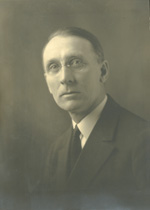 Literary scholar and baseball pitcher Edward M. Lewis enjoyed a diverse career before succeeding Kenyon Butterfield as Acting President of the Massachusetts Agricultural College from1924-26 and President from 1926-27. He had served as Acting President in 1912, as well.
Literary scholar and baseball pitcher Edward M. Lewis enjoyed a diverse career before succeeding Kenyon Butterfield as Acting President of the Massachusetts Agricultural College from1924-26 and President from 1926-27. He had served as Acting President in 1912, as well.
Lewis was born in Machynlleth, North Wales, and came to the United States in 1881 at the age of eight. While attending Williams College, he was so effective as a pitcher for the college baseball team that, on leaving Williams, he entered professional baseball, pitching for the Boston National League team for four years and the Boston Americans for one year.
In 1901, he began what was to be his life work-education-and he taught at Columbia, Williams, Harvard, and Yale before he came to the Massachusetts Agricultural College in 1911.
At the Massachusetts Agricultural College he was, first, assistant professor of English and assistant dean; later, head of the department of languages and literatures; and, for ten years, dean. As president, Lewis was noted for improving relations with the state commission on administration and finance. When state funding was insufficient, he called for seeking funding from the private sector. Lewis enjoyed politics, chairing the Massachusetts Democratic convention in 1913. He also ran for Congress, unsuccessfully. In 1927 he became president of the University of New Hampshire.
Massachusetts State College
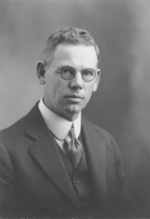 Roscoe W. Thatcher was the last president of the Massachusetts Agricultural College and the first when the institution changed its name to Massachusetts State College in 1931.
Roscoe W. Thatcher was the last president of the Massachusetts Agricultural College and the first when the institution changed its name to Massachusetts State College in 1931.
Thatcher was born and raised on a farm and specialized in agronomic research. Before coming to Amherst, Thatcher served as director of the agricultural station for the state of Washington. He went to the University of Minnesota in 1913, serving until 1917 as professor of plant chemistry. In 1917, he was appointed dean of the School of Agriculture and director of the Minnesota Experiment Station. In 1921, he became director of the New York Agricultural Experiment Station at Geneva.
In 1927 Thatcher accepted the Presidency of the Massachusetts Agricultural College. Under his leadership, the two year program in practical agriculture was expanded to become the Stockbridge School of Agriculture. The college achieved a record enrollment in 1929 of 894 students, 60 of whom were women. Thatcher oversaw curricular reform, orienting vocational training toward citizenship education. The student health service also started during his tenure.
Thatcher resigned due to ill health in 1933. Following a period of rest, Thatcher returned to the college in April 1933 as a research professor of agricultural chemistry. He died in his laboratory on December 6, 1933.
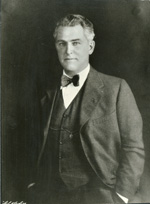 Hugh P. Baker served as President during most of the existence of Massachusetts State College. The institution changed its name from the Massachusetts Agricultural College in 1931, two years before Baker was appointed president. After he left office in 1947, the college became the University of Massachusetts.
Hugh P. Baker served as President during most of the existence of Massachusetts State College. The institution changed its name from the Massachusetts Agricultural College in 1931, two years before Baker was appointed president. After he left office in 1947, the college became the University of Massachusetts.
The primary goals of his presidency were building improved housing and classroom facilities for students and expanding the liberal arts curriculum. Special accomplishments during his tenure included the introduction of the AB degree in 1938, the development of a women's athletic field, and the completion of five dormitory buildings that provided space for all first year (male) students to live on campus. Baker also oversaw the building of Goodell Library, which enabled books to be relocated from the Old Chapel, and a near doubling of student enrollment. In 1946, new departments in geology and zoology were founded. Further, chapel services were reorganized to be voluntary, and a weekly convocation was initiated. Baker also founded popular annual conferences on recreation and country life.
Baker began his academic career in forestry, working as a professor and later dean of the College of Forestry at Syracuse University. He remained there until 1920, when he resigned to become executive secretary of the American Paper and Pulp Association. Throughout the 1920s, Baker was heavily involved in the forestry industry, holding no academic appointments. Baker returned to academic life in 1930, when he resumed the deanship at the New York State School of Forestry. A few years later, he became President of Massachusetts Agricultural College.
University of Massachusetts
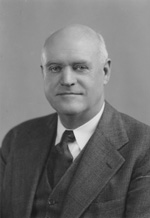 Ralph Van Meter was the first president of the University of Massachusetts. (Its name changed from the Massachusetts State College in 1947, the year Van Meter became acting president.)
Ralph Van Meter was the first president of the University of Massachusetts. (Its name changed from the Massachusetts State College in 1947, the year Van Meter became acting president.)
Van Meter spent nearly 40 years learning, teaching, and leading on the UMass Amherst campus. He attended The Ohio State University as an undergraduate, earning his B.S. in 1917. He came to the then Massachusetts Agricultural College as a specialist in Food Conservation in 1917. Later he served in the pomology department as a professor, becoming the head of the department from 1936 to 1948.
The Board of Trustees appointed Van Meter as acting president in 1947 and then president in 1948. He was responsible for a number of innovations, including the creation of the position of provost (first held by Jean Paul Mather) and the establishment of new schools of business administration and engineering. The University's physical plant expanded substantially under Van Meter's leadership, with 20 new buildings.
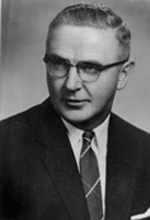 Jean Paul Mather was the youngest president in his era to lead a land-grant university. He joined the University of Massachusetts in 1953 as Provost, and in 1954, at the age of 39, was appointed President.
Jean Paul Mather was the youngest president in his era to lead a land-grant university. He joined the University of Massachusetts in 1953 as Provost, and in 1954, at the age of 39, was appointed President.
During his tenure, major academic restructuring took place. The College of Arts and Sciences was formed from the merger of the School of Science and the School of Art. The Schools of Education and Nursing were inaugurated. In addition, the faculty senate was organized.
Mather advocated fiscal autonomy for the University and struggled with state officials to raise salaries for the faculty. In 1956, he gained authority from the state to appoint faculty without state approval. His work is credited with building a foundation for the academic strength of the University. Several important campus buildings were completed under his leadership, including the Morrill Science Center, the Student Union, Bartlett Hall and Machmer Hall.
Mather left UMass in 1960 to assume the presidency of the American College Testing Program. He later became president of the University City Science Center in Philadelphia from 1964 to 1969. In 1969, Mather returned to his alma mater, the Colorado School of Mines, to become head of the mineral economic department.
He received honorary degrees from American International College, Amherst College, Northeastern University, The University of Rhode Island, Hokkaido University of Japan, Lowell Tech, and Lesley College.
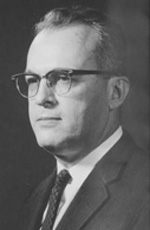 John W. Lederle played a large role in shaping the UMass Amherst campus as it looks today. He led the charge for UMass Amherst becoming a nationally respected research university, a "great public center for excellence in higher education."
John W. Lederle played a large role in shaping the UMass Amherst campus as it looks today. He led the charge for UMass Amherst becoming a nationally respected research university, a "great public center for excellence in higher education."
Under the leadership of Lederle, the Amherst campus enjoyed its greatest period of growth. From 1960 to 1970, student enrollment more than tripled and faculty salaries nearly doubled. Lederle won freedom from state hiring regulations, and the number of faculty grew from 366 to 1157. The academic program expanded greatly, particularly at the graduate level, and several centers were formed, including the Research Computing Center, the Polymer Research Institute, and the Five College Radio Astronomy Observatory. Other innovations included the university press, a public radio station, and collaborative arrangements between the local colleges. The University's first endowed professorship was established. Attracting federal research dollars, the institutional budget grew by 700 percent to over $100 million. Many new buildings were completed or initiated, with work begun on the graduate research tower, the library, and the campus center.
The University system also evolved in the Lederle years, with the establishment of the UMass Medical School in Worcester in 1962 and the UMass Boston campus in 1964.
Born in Royal Oak, Michigan, Lederle received his Ph.D. in 1942 from the University of Michigan. He was admitted to the Michigan Bar in 1936, working with a Detroit law firm from 1936 to 1940. Lederle worked at Brown University from 1941 to 1944, serving as a professor of political science and assistant dean. He returned to the University of Michigan in 1944, filling a number of professional roles. Lederle remained at the University of Michigan until 1960, when the University of Massachusetts elected him president of the University.
After his retirement in 1970, Lederle was honored with an appointment to the Joseph B. Ely Chair in Government at the University.
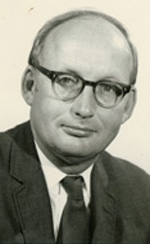 Born in St. Louis on September 16, 1923, Robert C. Wood graduated from Princeton in 1946, Phi Beta Kappa, after serving with the army in WWII during which he was awarded the Bronze Star. He received his master's degree in 1947 and his M.B.A. the following year, both from Harvard. In 1950, Harvard granted him his Ph.D. Wood served as Associate Director of the Florida Legislative Reference Bureau from 1949-1951, moving on to the federal government to act as a management organization expert for the Bureau of the Budget from 1951-1953. He returned to Harvard in 1953 to become an assistant professor of government until 1957. Wood then joined the faculty of the Massachusetts Institute of Technology as a professor in the political science department, serving as head of the department in 1965-66. Wood went back to Washington D.C. in 1966 to become undersecretary in the Department of Housing and Urban Development. He was appointed Secretary in 1969. When his term expired, Wood reassumed his position of head of MIT's Political Science Department along with serving as Director of the Harvard-MIT Joint Center for Urban Studies, and chairman of the Massachusetts Bay Transit Authority Advisory Board, all during 1969-1970.
Born in St. Louis on September 16, 1923, Robert C. Wood graduated from Princeton in 1946, Phi Beta Kappa, after serving with the army in WWII during which he was awarded the Bronze Star. He received his master's degree in 1947 and his M.B.A. the following year, both from Harvard. In 1950, Harvard granted him his Ph.D. Wood served as Associate Director of the Florida Legislative Reference Bureau from 1949-1951, moving on to the federal government to act as a management organization expert for the Bureau of the Budget from 1951-1953. He returned to Harvard in 1953 to become an assistant professor of government until 1957. Wood then joined the faculty of the Massachusetts Institute of Technology as a professor in the political science department, serving as head of the department in 1965-66. Wood went back to Washington D.C. in 1966 to become undersecretary in the Department of Housing and Urban Development. He was appointed Secretary in 1969. When his term expired, Wood reassumed his position of head of MIT's Political Science Department along with serving as Director of the Harvard-MIT Joint Center for Urban Studies, and chairman of the Massachusetts Bay Transit Authority Advisory Board, all during 1969-1970.
Dr. Wood was appointed President in 1970 by the Board of Trustees, serving until 1977, when he resigned. Late in 1977, Wood was appointed Superintendent of the Boston Public Schools. He was the author of six books, including Suburbia: Its People and Their Politics.
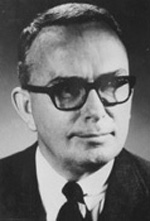 Franklin K. Patterson was born in Ellsworth, Iowa, on September 14, 1916. He attended Occidental College, receiving his B.A. in 1939, and moved on to UCLA to obtain his M.A. in 1941. During World War II, he served in the Air Force from 1942 to 1946, rising to the rank of captain. After the war, he became a teacher in the Pasadena Public Schools. In 1951, Patterson moved east to serve as associate educational director and greater New York area administrator of the National Conference of Christians and Jews. He became a faculty member at New York University as associate professor and chairman of the Department of Secondary Education in 1954, serving until 1957. In 1955, he was awarded the Ph.D. by Claremont Graduate School. From 1957 to 1966, Patterson was the Lincoln-Filene Professor of Citizenship and Public Affairs at Tufts University and served as Director of the Lincoln-Filene Center.
Franklin K. Patterson was born in Ellsworth, Iowa, on September 14, 1916. He attended Occidental College, receiving his B.A. in 1939, and moved on to UCLA to obtain his M.A. in 1941. During World War II, he served in the Air Force from 1942 to 1946, rising to the rank of captain. After the war, he became a teacher in the Pasadena Public Schools. In 1951, Patterson moved east to serve as associate educational director and greater New York area administrator of the National Conference of Christians and Jews. He became a faculty member at New York University as associate professor and chairman of the Department of Secondary Education in 1954, serving until 1957. In 1955, he was awarded the Ph.D. by Claremont Graduate School. From 1957 to 1966, Patterson was the Lincoln-Filene Professor of Citizenship and Public Affairs at Tufts University and served as Director of the Lincoln-Filene Center.
In 1966, Patterson became President of Hampshire College and was appointed founder president in 1971. In 1971, he became a Frank L. Boyden Professor at the University of Massachusetts and secretary to the Board of Trustees from 1972 - 1974. In 1978 he was named interim president of the University.
Dr. Patterson was the recipient of honorary degrees from UMass, Amherst, Brandeis, and American International College. He was the author of numerous books and pamphlets.
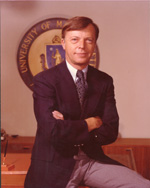 Born in Syracuse, New York, in 1927, Dr. David C. Knapp received his B.A. from Syracuse University in 1947. He entered the University of Chicago; earning his M.A. in 1948 and his PhD in 1953. He joined the faculty of the University of New Hampshire in 1953 as an assistant professor of government. From 1955 to 1961, he assumed the duties of assistant to the president in addition to that of associate professor. Dr. Knapp served as Dean of the College of Liberal Arts for 1961-1962.
Born in Syracuse, New York, in 1927, Dr. David C. Knapp received his B.A. from Syracuse University in 1947. He entered the University of Chicago; earning his M.A. in 1948 and his PhD in 1953. He joined the faculty of the University of New Hampshire in 1953 as an assistant professor of government. From 1955 to 1961, he assumed the duties of assistant to the president in addition to that of associate professor. Dr. Knapp served as Dean of the College of Liberal Arts for 1961-1962.
In 1963, Dr. Knapp became associate director of the Study of American Colleges of Agriculture. The study was financed by the Carnegie Corporation, and was centered at the University of Maryland. While still working on the study, Dr. Knapp became director of the Institute of College & University Administrators of the American Council on Education. He left both posts in 1968 to accept an appointment as dean of the New York State College of Human Ecology at Cornell University, a position he held until being appointed provost in 1974.
Dr. Knapp was elected president of the University of Massachusetts by the Board of Trustees in 1978.
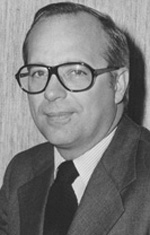 Joseph D. Duffey has the unique distinction of having served as both Chancellor of the Amherst campus and President of the University of Massachusetts system simultaneously. He held both positions from March, 1990 through July, 1991.
Joseph D. Duffey has the unique distinction of having served as both Chancellor of the Amherst campus and President of the University of Massachusetts system simultaneously. He held both positions from March, 1990 through July, 1991.
Duffey came to the University of Massachusetts Amherst in 1982 from the National Endowment for the Humanities, which he chaired from 1977-1981. Before chairing NEH, Duffey served briefly in the U.S. State Department as the assistant secretary of state for education and cultural affairs.
During his tenure as Chancellor, Duffey was credited with improving the image of the University. A new general education curriculum was implemented. He believed that the goal of education was benefitting global civilization and contributing to the formation of new values. In 1986, an effort known as "Mass Transformation" involved some 4,000 members of the campus community in renovating 23 floors of the University library. The Campus Chronicle began publication during his tenure.
Duffey earned his B.A. degree from Marshall University in West Virginia, and later became an ordained Congregationalist minister before earning his doctoral degree from Hartford Seminary Foundation in 1969. During his academic and professional career, he was awarded at least 13 honorary degrees from universities across the country.
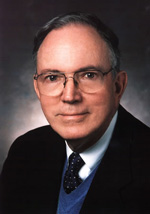 E.K. Fretwell was trained as a professor of English and started his teaching career as an elementary teacher in Brookline. He eventually served as the president of the State University of New York at Buffalo, and after that as the chancellor of the University of North Carolina at Charlotte. From this post he stepped down when he reached North Carolina's mandatory retirement age in 1989.
E.K. Fretwell was trained as a professor of English and started his teaching career as an elementary teacher in Brookline. He eventually served as the president of the State University of New York at Buffalo, and after that as the chancellor of the University of North Carolina at Charlotte. From this post he stepped down when he reached North Carolina's mandatory retirement age in 1989.
The University system expanded during Fretwell's tenure, when the Lowell and Dartmouth campuses (previously the University of Lowell and Southeastern Massachusetts University) were consolidated into the University under Chapter 142 of the Acts of 1991.
On July 1, 1991, he was named interim president for the University of Massachusetts system.
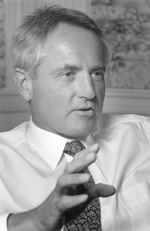 Michael K. Hooker was born on August 24, 1945, the only child of a coal miner in southwest Virginia. He graduated summa cum laude with a B.A. from the University of North Carolina in philosophy in 1969 and went on to earn M.A. and Ph.D. degrees at the University of Massachusetts Amherst in 1972 and 73, respectively. From 1973-75, he was assistant professor in the department of philosophy at Harvard University and then moved on to a similar position at Johns Hopkins University from 1975-1977. From 1977-78, he was assistant dean of undergraduate and graduate Studies, and from 1978-80 associate dean of undergraduate and graduate Studies, and from 1980-82, he served as dean. From 1982-86, he held the position of president at Bennington College in Vermont, and from 1986-92 at the University of Maryland Baltimore County.
Michael K. Hooker was born on August 24, 1945, the only child of a coal miner in southwest Virginia. He graduated summa cum laude with a B.A. from the University of North Carolina in philosophy in 1969 and went on to earn M.A. and Ph.D. degrees at the University of Massachusetts Amherst in 1972 and 73, respectively. From 1973-75, he was assistant professor in the department of philosophy at Harvard University and then moved on to a similar position at Johns Hopkins University from 1975-1977. From 1977-78, he was assistant dean of undergraduate and graduate Studies, and from 1978-80 associate dean of undergraduate and graduate Studies, and from 1980-82, he served as dean. From 1982-86, he held the position of president at Bennington College in Vermont, and from 1986-92 at the University of Maryland Baltimore County.
In 1992, he became the president of the University of Massachusetts, from which position he resigned in 1995 to become chancellor of the University of North Carolina at Chapel Hill.
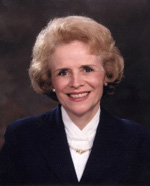 Sherry H. Penney served as interim president of the University of Massachusetts from 1995 until 1996.
Sherry H. Penney served as interim president of the University of Massachusetts from 1995 until 1996.
Dr. Penney is currently the "Sherry H. Penney Professor of Leadership" in the College of Management at the University of Massachusetts Boston. She also is the founding director of the Center for Collaborative Leadership there.
Dr. Penney previously served as the chancellor of UMass Boston, 1988-2000. Previously, she was the vice chancellor for academic programs, policy and planning for the SUNY system and prior to that appointment she was associate provost at Yale University.
She has published several articles in professional journals and is the author of "Patrician in Politics: Daniel Dewey Barnard of New York" which deals with New York politics in the 19th Century. She also is co-author with James D. Livingston of a biography of the l9th century feminist and abolitionist Martha Coffin Wright entitled, "A Very Dangerous Woman: Martha Wright and Women's Rights" UMass Press (2004). She has taught at Yale University, Union College, SUNY Albany, and the University of Massachusetts Boston.
She currently serves on several boards, including NSTAR and TERI (The Education Resource Institute) which she chairs. She also is on the Board of Directors for HERS (Higher Education Resource Services) and the South Shore Hospital. In addition, she is on the Board of Advisors for the Road to Seneca Falls project in women's history.
Previously she served on the boards of the Greater Boston Chamber of Commerce, the New England Council, the Boston Municipal Research Bureau, the Boston Plan for Excellence in the Public Schools, the Private Industry Council, the Boston Coalition, the John F. Kennedy Library Foundation, the New England Aquarium, the Environmental Business Council, the Carnegie Foundation for the Advancement of Teaching (vice chair), the American Council on Education and the National Center for Higher Education Management Systems (NCHEMS) where she also served as Chair of the Board. In addition, she was previously a member of the Board of Visitors of Women's Education and Industrial Union (WEIU), the Governor's International Trade Task Force (1995-96) and the Governor's Council for Economic Development (1995-2000).
She has received honorary degrees from Albion College in Michigan and from Quincy College. She has received several awards including the Pinnacle Award for lifetime achievement from the Greater Boston Chamber of Commerce, the New England Women's Leadership Award, the Distinguished Citizen Award for Racial Harmony from Black/White Boston, the College Club Award, and the Abigail Adams Award from the Massachusetts Women's Political Caucus.
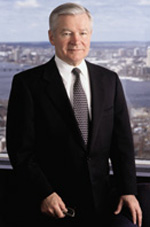
William M. Bulger served as the 24th president of the University of Massachusetts and played a major role in creating and building the five-campus UMass system.
During his seven-year tenure, President Bulger’s accomplishments included attracting top students to the University, increasing private and public financial support, stressing the importance of access and affordability, and winning new appreciation for the system’s impact and quality. He was credited with significantly strengthening and elevating what had only recently become a five-campus system, with the addition of campuses in Dartmouth and Lowell.
President Bulger's appointment by the University of Massachusetts Board of Trustees followed his 35-year career as a leading state lawmaker.
Throughout his presidency (January 1996 to September 2003), Bulger had great appreciation for the campus chancellors and their staffs, for the faculty, for UMass students and for the University’s mission and role. “It isn’t too much to say that as UMass goes, so goes to Commonwealth,” he told an interviewer during his first year in office.
Ensuring affordability and raising money for scholarships were priorities during the Bulger years, as never far from President Bulger’s mind were the financial hurdles he had to surmount to attend college and the defining difference that higher education made in his life.
In his UMass inaugural address, President Bulger underscored the importance of the humanities and said society needed to be alert to the entertainment- and technology-driven rise of a “culture of trivial distractions.” Where in that culture, he asked, would young people discover “the beauties of Shakespeare and the modern universal voices of conscience ranging from Gandhi to Dr. Martin Luther King Jr.?”
“The Humanities provide the ennobling grace essential to our lives,” he said.
Under his leadership, UMass began the process of upgrading campus facilities, built closer ties with the business community and created its UMassOnline distance-education program. Additionally, President Bulger appointed the first woman to lead the University’s flagship campus in Amherst (Marcellette G. Williams), as well as female chancellors at UMass Boston (Jo Ann Gora) and UMass Dartmouth (Jean MacCormack).
Five years into Bulger’s presidency, UMass Amherst Professor Ernest May, secretary of the flagship campus’s Faculty Senate, told The Boston Globe: “We’re moving along the right path, and Bulger should get credit for that. I’d give him quite high marks.”
William F. Weld, whose governorship spanned Bulger’s Senate and UMass presidencies, said: “During those years, I came to know Bill Bulger as a man of honesty, integrity, compassion and strong character.”
In the 2021 documentary film “My Name Is Bulger,” former Governor Michael S. Dukakis described President Bulger as “one of the most effective presidents of the University of Massachusetts we’d ever had” and credited him with playing a key role in bringing reform to state government in Massachusetts.
“The state government that he and I entered in 1960 and 1962 as young state legislators was one of the three or four most corrupt in America. Bill Bulger was the guy that brought integrity to the Massachusetts State Senate … And we’re benefitting from that now.”
“Leading the University of Massachusetts was a labor of love for William M. Bulger, and based on his performance, he must be considered one of the truly great presidents in UMass history,” said Grace K. Fey, former chair of the UMass Board of Trustees. “Coming to UMass after a distinguished career in public service, President Bulger understood the importance of external matters like fundraising and building bridges to the business community. At the same time, he was an intellectual who was dedicated to scholarship and academic quality. He had deep respect for faculty and for the many services that faculty provide to the University, the Commonwealth and the world. While his leadership was wide-ranging and his interests diverse, it was always clear that students were the centerpiece of his presidency and that his decisions and actions focused on improving the student experience, maintaining student affordability and ensuring the University’s ability to transform lives and build bright futures for its students and for Massachusetts.”
Marcellette G. Williams, who served as chancellor of UMass Amherst and later as UMass system senior vice president for Academic Affairs, Student Affairs and International Relations, described President Bulger as “someone who understood the strengths of a developing public research university, with its integrative land-grant charge of knowledge discovery, education and engagement with the Commonwealth, the nation and the world. He was an unapologetic advocate for the University of Massachusetts, with its stellar faculty and bright, prepared students.”
Dr. Williams said the Bulger presidency helped to ignite “the exponential growth and success that followed over the next several years.”
Attending President Bulger’s inauguration in 1997, Jack Welch, a UMass Amherst graduate then serving as Chairman and CEO of General Electric Co., said: “This is a defining moment for UMass. And it’s lucky to have a president with the vision and commitment that Bill Bulger has to put it on the map.”
Pulitzer Prize–winning historian David McCullough, who spoke at President Bulger’s inauguration, said: “He loves what matters in life … Oh, what I would give to see Bill Bulger and John Adams sit down for an evening of good conversation. That would be great.”
Before he arrived at UMass, the South Boston native served as president of the Massachusetts Senate from 1978 to 1996 – the longest tenure in state history. His legislative career began when he was elected to the Massachusetts House of Representatives in 1960. On his first day as a member of the House, he witnessed John F. Kennedy deliver his “City on a Hill” speech as JFK prepared to leave for Washington DC for his presidential inauguration. A decade later, Bulger was elected to the Massachusetts Senate, where he championed education, the protection of children and funding for public libraries. He was one of the architects of a groundbreaking education reform law that reduced the funding inequities between rich and poor communities.
President Bulger was a strong environmentalist and championed the effort that resulted in the cleanup of Boston Harbor. As Senate president, understanding the importance of Massachusetts having a world-class public research university, he strongly supported the bill that in 1991 created the five-campus UMass system. President Bulger led the Senate through its debate on changes to the state’s welfare system in 1995. During that debate, took the rare step of surrendering the gavel, so he could argue for a less punitive revisions, noting: “After we have eaten, we forget there is such a thing as hunger.”
Growing up in the Old Colony public housing development in South Boston, Bulger recognized the importance of education. He graduated from Boston College High School in 1952. After high school, Bulger believed that college was beyond his financial reach, but the Jesuits of BC High funded his first year at Boston College. After that freshman year, Bulger enlisted in the U.S. Army, was stationed in Korea during part of his tour of duty and used his veteran’s benefit to return to Boston College in 1955, completing an undergraduate degree in English in 1958. He earned a Doctor of Jurisprudence degree from Boston College Law School in 1961. He is the author of the acclaimed memoir, “While the Music Lasts: My Life in Politics.”
William M. Bulger was born on February 2, 1934, the son of James and Jane (McCarthy) Bulger. He and his late wife, Mary Foley Bulger, raised nine children in South Boston and have more than 30 grandchildren.
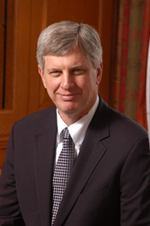 Jack M. Wilson served as the 25th president of the University of Massachusetts from September 2, 2003 to June 30, 2011.
Jack M. Wilson served as the 25th president of the University of Massachusetts from September 2, 2003 to June 30, 2011.
During his career, President Wilson held positions as Professor of Physics, Department Chair, Research Center Director, Dean, Vice President, Provost, and a private sector entrepreneur. At the University of Massachusetts, he was previously the Vice President for Academic Affairs and founding CEO of UMassOnline.
Prior to arriving at UMass, President Wilson was the J. Erik Jonsson '22 Distinguished Professor of Physics, Engineering Science, Information Technology, and Management at Rensselaer Polytechnic Institute, where he held positions as Dean, Research Center Director, and Provost. Before being appointed at Rensselaer, he served at the University of Maryland, College Park, and as an officer of the American Association of Physics Teachers, the American Institute of Physics, and the American Physical Society.
At the University of Massachusetts, President Wilson called for a rededication to the land grant mission of accessibility, research and discovery in the public interest, as it might be viewed in the context of a modern innovative society. He emphasized the critical role that the University played as the state's innovation engine, asserting that: "The path to economic and social development in Massachusetts goes through the University of Massachusetts."
President Wilson believed that providing ample amounts of financial aid was the key to maintaining access and affordability for lower- and middle-income students. To that end, UMass increased its own spending on financial aid from $36 million in Fiscal Year 2003 to $131.5 million in Fiscal Year 2011, an increase of 267 percent.
Research activity at UMass grew by $217 million during Jack Wilson's presidency with expenditures rising from $324 million in Fiscal Year 2003 to $541 million in Fiscal Year 2010. By 2011, UMass ranked among the top universities nationally in generating licensing and royalty income from faculty inventions and discoveries. Annual intellectual property income rose from $20 million as President Wilson was taking office to $41 million during Fiscal Year 2010.
During President Wilson's tenure, the University's endowment grew from $146 million to $522 million as of March 31, 2011, an increase of 257 percent. The University's endowment was well managed, and investment performance during the global economic crisis was in the top quartile nationally.
During the Wilson presidency, UMass dramatically increased its own spending on capital projects, spending $2 billion on construction and repair, adding new classrooms, labs, student recreation facilities and student housing, and in the process significantly upgrading all five campuses. One of President Wilson's first actions as President was to bring new leadership to the UMass Building Authority, the agency that borrows money for the University and oversees many capital projects. UMass now provides most of the funding for the capital projects that take place on its campuses.
Starting in 2004, President Wilson created three presidential grant programs to encourage UMass faculty research and discoveries that contribute to the Commonwealth's innovative and creative economies. He established international programs as a major priority and recruited the first Vice President to carry the title "International Relations." He identified Africa, Japan, China, Germany, India, and the Portuguese language countries as primary targets of opportunity, building on existing relationships of the University and his own work. In 2008, President Wilson expanded the University's global engagement by signing a groundbreaking agreement to establish UMass as the first foreign university approved to provide online education in China.
In addition, President Wilson supported the establishment of the UMass Law School, which was unanimously approved by the Massachusetts Board of Higher Education in February 2010. He was also a leader of the public-private effort to build a Green High Performance Computing Center in Holyoke near UMass Amherst.
As founding CEO of UMassOnline, President Wilson built the system-wide initiative into one of the largest externally directed online education programs in the United States, which offered more than 92 fully accredited degree and certificate programs serving over 45,000 enrollees. Since its inception in early 2001, the online consortium achieved double-digit growth in both enrollments and revenues. In Fiscal Year 2010, UMassOnline saw course enrollments rise from 33,900 to 45,815 and revenues increase to $56.2 million.
President Wilson was the founder, CEO, and Chairman of the LearnLinc Corporation, founded in 1993 as a spin-off of his university research. After several mergers, he formed the publicly traded (NASDAQ) Mentergy Corporation, leaving the company in the next year. President Wilson's expertise in building links between higher education, government and business led to his becoming the co-founder of the Paul Severino Center for Technological Entrepreneurship as well as other programs. He has consulted for many computing and communications firms, including IBM, AT&T, Lucent, Hewlett Packard, and Boeing Flight Safety International.
President Wilson is nationally and internationally known for his leadership in the reform of higher education initiatives. He won the Theodore Hesburgh Award, the Boeing Award, and the Pew Charitable Trust Prize for his innovative programs. President Wilson was awarded an Outstanding Civilian Service Medal by the U.S. Army for service to the Army Education program. He is a Fellow of the American Physical Society.
President Wilson earned his bachelor's degree at Thiel College in 1967, his master's degree in 1970 and his doctorate in 1972 in Physics, both from Kent State University. He lives with his wife Judi and their two children, John and Jessica, in Westborough, Massachusetts. He also has two grown daughters, Erika and Gretchen, and four wonderful grandchildren.
On June 30, 2011, President Wilson stepped down and became President Emeritus. He serves as Distinguished University Professor of Higher Education, Emerging Technologies and Innovation at UMass Lowell.
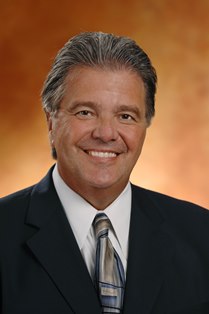 Robert L. Caret served as the 26th president of the University of Massachusetts from July 1, 2011 to June 30, 2015.
Robert L. Caret served as the 26th president of the University of Massachusetts from July 1, 2011 to June 30, 2015.
Prior to assuming the leadership of the University of Massachusetts, Dr. Caret, a native New Englander, was the president of Towson University in Maryland from 2003 to 2011 and gained national acclaim for eliminating race-based graduation disparities. He also served as a faculty member, dean, executive vice president and provost during his more than 25-year tenure there.
At Towson, President Caret created partnerships with regional business, non-profit and civic organizations, raised student graduation rates, and undertook a capital fundraising and building campaign to support campus infrastructure improvements and the construction of numerous academic and student life facilities. Between 1995 and 2003, Dr. Caret served as president of San Jose State University, where he championed a joint city/university effort to build the Martin Luther King, Jr. Library in San Jose.
As president of the University of Massachusetts, Dr. Caret established himself as a major spokesperson on the pressing issues of college affordability and student debt, calling for Massachusetts and states across the nation to rededicate themselves to their public universities and provide appropriate levels of funding. In Massachusetts, President Caret successfully pursued a 50-50 funding formula for UMass, with the state and students contributing equally to the University's general education program. His success in securing additional state funding from the Legislature allowed UMass to freeze tuition and mandatory fees for in-state undergraduate students for two consecutive years.
Under President Caret's leadership, research expenditures topped the $600 million mark and UMass became a national leader in patents and licensing income. Enrollment rose, the endowment grew to more than $757 million and private donations to the university increased significantly. The university made dramatic gains on prominent college ranking lists and was named the No. 1 public university in New England and among the top 100 universities in the world by The Times Higher Education World University Rankings, considered the most rigorous and influential comparisons of universities internationally.
President Caret also emphasized efficiency and transparency, rolling out a number of cost-saving initiatives as part of his focus on both administrative and academic efficiencies. In addition, President Caret created a new accountability report, UMass Performance: Accountable and on the Move, that lays out the University's goals as they relate to six focal areas: Student Experience & Success; Producing an Educated Workforce and Engaged Citizenry; World Class Research & Development Enterprise; Enhancing the Social Well Being; Good Stewards of Resources; and Telling and Selling the UMass Story. A system-wide "Here for a Reason" advertising campaign that strengthened the UMass brand and reminded citizens of its land grant mission won national awards.
Born in Biddeford, Maine to a restaurant owner, President Caret was the first in his family to attend college. He received his Ph.D. in organic chemistry from the University of New Hampshire in 1974 and his bachelor's degree in chemistry and mathematics from Suffolk University in 1969. His honorary degrees include a Doctor of Humane Letters from Saint Joseph's College of Maine and Westfield State University (2012) San Jose University (2004) and National Hispanic University (1997) and a Doctor of Science degree from Suffolk University (1996).
